So the other day I tried a recipe that sounded wonderful. I had a pork loin thawed out and looked for a recipe in my favorite America’s Test Kitchen online site. The recipe sounded totally yummy and I had almost all the ingredients. As always I followed the directions to the tee. I had enough filling for at least three good sized pork loins, so froze the two left over rolls. But I would cut everything in the stuffing by fourths, as there was way too much. I would also experiment with temperature and cooking times. My pork loin was so overdone, it tasted like it had been smoked. So here is a photo of my sad looking pork loin and below is what it should have looked like.
The glaze from the Apricot Preserved puddled on the foil (luckily I wrapped the pan with a double layer of tin foil) and filled the house with the lovely smell of burnt apricots. My husband was working upstairs in the house and the smell drifted upstairs and he was afraid I caught the house on fire.
The pork was totally dry and very overcooked. The stuffing was dry and overcooked.
This is the first recipe I have tried from America’s Test Kitchen that was a total failure. Usually I love their recipes. It seemed when I originally read the recipe that it was way too long and way too hot to cook pork loin. Hum, seems to be the right reaction. I will try it again, but at a lower temperature to cook it and a lot less of the Apricot Preserves, so no major burning. I guess we do learn from our mistakes.

Roast Pork Loin with Apricot, Fig, and Pistachio Stuffing
WHY THIS RECIPE WORKS
To ensure that our stuffed pork loin recipe would give us moist meat and a flavorful stuffing in one cohesive package, we first brined our boneless pork roast for flavor and texture and then butterflied and pounded it to an even thickness, increasing the meat’s surface area to maximize the amount of stuffing we could use. For the stuffing in our pork loin recipe, we used fresh bread as a base and flavored it with dried fruit, nuts, and herbs, adding eggs as a binder. Prebaking the stuffing before stuffing the roast got it to a temperature high enough that we didn’t have to roast the stuffed pork until it was dry and overcooked.
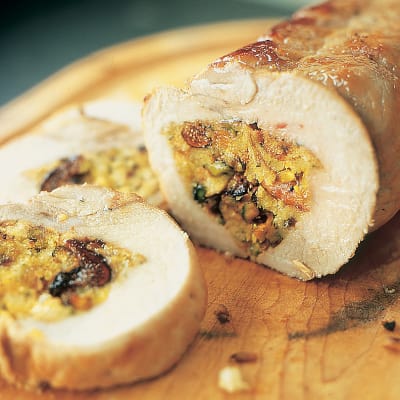
INGREDIENTS
Roast
| 1 | boneless pork loin roast (4 1/2 pounds), from the blade end |
Brine
| ¾ | cup granulated sugar |
| ¾ | cup kosher salt (or 6 tablespoons table salt) |
| 3 | bay leaves, crumbled |
| 1 | tablespoon allspice berries, lightly crushed |
| 1 | tablespoon whole black peppercorns, lightly crushed |
| 10 | medium cloves garlic, lightly crushed and peeled |
Stuffing
| 5 | cups roughly torn 1-inch pieces baguette (not sourdough) (7 to 8 ounces),from 1 baguette |
| ½ | cup dried apricots (about 4 ounces) |
| 1 | medium clove garlic, peeled |
| pinch ground cumin |
| pinch ground coriander |
| pinch ground cinnamon |
| pinch cayenne pepper |
| 2 | tablespoons grated onion from 1 small onion |
| ½ | cup dried figs, halved lengthwise (about 3 ounces) |
| ½ | cup shelled pistachios (about 3 ounces), toasted in medium skillet over medium heat until color deepens slightly, 3 to 5 minutes, then cooled and chopped coarse |
| 2 | teaspoons minced fresh thyme leaves |
| 2 | tablespoons minced fresh parsley leaves |
| 1 ½ | teaspoons kosher salt (or 1 teaspoon table salt) |
| Ground black pepper |
| 2 | large eggs |
| ½ | cup heavy cream |
Glaze
| ½ | cup apricot preserves |
INSTRUCTIONS
SERVES 8 TO 10
Timing is important. The goal is to coordinate brining and stuffing so that the pork is out of the brine and ready to be stuffed when the pre-cooked stuffing comes out of the oven. To achieve this, begin preparing the stuffing ingredients immediately after setting the pork in the brine. Bamboo skewers, available in supermarkets (or see below), are our favorite way to fasten the roast around the stuffing. Alternatively, use poultry lacers (though they are generally sold only six to a package). The apricot preserves for the glaze can be melted in the microwave instead of on the stovetop. To do so, heat the preserves in a small, microwave-safe bowl, covered loosely with plastic wrap, at full power until melted, about 40 seconds.
1. Following illustrations 1 through 4, (see “Step by Step: Ready The Roast,” below) trim, butterfly, and pound pork loin to even 1-inch thickness with mallet or bottom of heavy skillet.
2. For the Brine: In a large, wide bowl, dissolve sugar and salt in 3 cups hot water. Add bay, allspice, peppercorns, garlic, and 5 cups cold water; stir to combine. Add butterflied and pounded pork; cover bowl with plastic wrap and refrigerate until fully seasoned, about 1 1/2 hours. Remove pork from brine, pick spices off meat, and dry pork thoroughly with paper towels.
3. For the Stuffing and Glaze: Once the pork is in the brine, adjust oven rack to lower-middle position and heat oven to 325 degrees. Process half the bread pieces in workbowl of food processor fitted with steel blade until broken into crumbs with few pieces no larger than about 1/4 inch, about 45 seconds; transfer to large mixing bowl and set aside. Repeat process with remaining bread pieces (you should have about 4 cups crumbs total).
4. In now-empty workbowl, process apricots, garlic, cumin, coriander, cinnamon, and cayenne until finely ground, about 30 seconds; add mixture to reserved bread crumbs. Add onion, figs, pistachios, thyme, parsley, salt, and pepper to taste to bread crumb and apricot mixture; toss until well distributed, breaking up any apricot clumps as necessary. Beat eggs and cream in small bowl; pour over bread and apricot mixture and toss with hands until evenly moistened and a portion of mixture holds together when pressed.
5. On parchment paper–lined cookie sheet or inverted rimmed baking sheet, form stuffing into log shape equal in length to butterflied pork. Cover stuffing with foil and bake until firm and cooked through and butterflied pork has been removed from brine and prepared for stuffing, about 45 minutes. Remove stuffing from oven; increase oven temperature to 450 degrees.
6. While stuffing bakes, heat apricot preserves in small saucepan over medium-low heat, stirring occasionally, until melted but not liquefied, 5 to 7 minutes. Strain through small strainer into small bowl (you should have about 1/3 cup) and set aside; discard solids in strainer.
7. To Stuff, Roast, and Glaze the Roast: Line shallow roasting pan or rimmed baking sheet with foil, position flat wire roasting rack over foil, and set aside. Following illustrations 5 through 8 (see “Step by Step: Ready The Roast,” below), stuff, roll, fasten, and tie pork loin. Place stuffed roast on rack, brush one-half apricot glaze evenly over exposed surface of meat and roast 20 minutes. Remove roast from oven and, with tongs, rotate roast so that bottom side faces up. Brush exposed surface with remaining apricot glaze; return roast to oven and roast 25 minutes longer (glaze should be medium golden brown and internal temperature of both meat and stuffing should register 145 to 150 degrees on instant-read thermometer). Transfer roast to carving board, tent with foil, and let rest 5 minutes. Cut off twine, slice, and serve.
STEP-BY-STEP
Ready the Roast
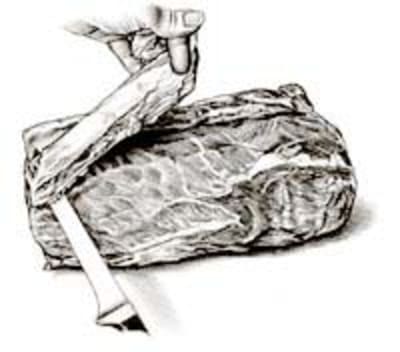
1. Using a boning knife, trim the tough silver skin from the pork loin.
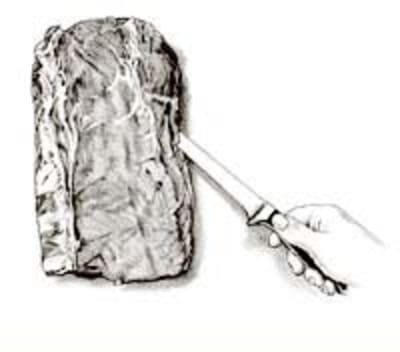
2. Lay the loin on the cutting board and begin to slice laterally through the center, starting at the thinner edge.

3. As you slice, open the meat as you would a book. Stop slicing 1 inch shy of the edge to create a hinge.

4. Cover the surface with plastic wrap and pound the meat to a 1-inch thickness.

5. Cut eight 24-inch pieces of kitchen twine. Break nine 10- or 12-inch bamboo skewers in half.

6. Roll the hot stuffing onto the center of the butterflied pork, over the hinge.
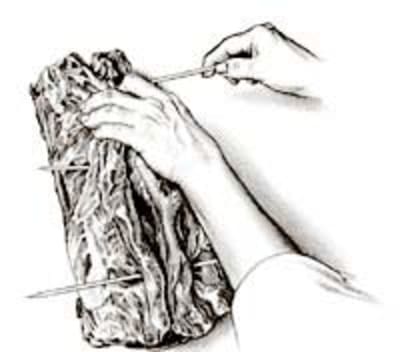
7. Bring both sides of the meat together over the stuffing and fasten at the center with one skewer. Fasten the roast with the remaining skewers placed at regular intervals.
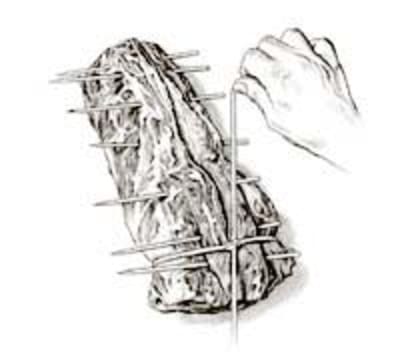
8. Shimmy lengths of twine one by one down the roast and tie them between the skewers, as shown. Trim the twine and remove the skewers before roasting.